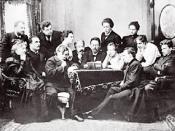Symbolism is the method of making a character or an action, a situation or a setting, stand for more than it. Symbolist theater attempted to dramatize more poetic or metaphorical situations, often using unusual stage setting and ethereal dramatic action and language. The Seagull By Anton Chekhov is a great example of symbolism. The play explores the relationship between a young man and his mother by drawing parallels to the relationship between true art and the appearance of art through conformity. It explores the concepts of love and death within the context of theatre and literature. The protagonist of Chekhov's play, Konstanin, searches for his own identity through his writing. Konstanin believes himself "insignificant." His mother, Arkadina, is a star of the theatre, his mother's lover, Trigorin, is a "famous" author.
At the opening of the play, Masha, a character later revealed to be in love with Konstanin, explains why she wears only black clothing.
"I am in mourning for my life," she proclaims. Masha is one of the most appealing characters in the play, for unlike the others, she is aware of the ghostly state in which they function. Despite her intuitiveness, she consciously chooses to conform to the appearance of being alive to which the others in the play so eagerly cling. Arkadina saves all her money for her costumes. She believes her costumes are what make her a successful actress, as if she herself were unnecessary, a skeleton to fill the appropriate clothing.
Nina and Trigorin parallel struggle to overcome the frustrations of reality and to establish a real artistic identity is symbolized by the central image of the seagull. Nina is a young girl who at the beginning has a mutual relationship with Konstanin and the star of his play. Nina's identification with a...



The Seagull
This was fun to read. There are some good points. Nice
2 out of 2 people found this comment useful.